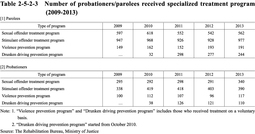2 Measures for providing treatment for probationers and parolees
Treatment needs to be provided according to the circumstances of the individual probationers/parolees. The treatment has also been improved through the use of various measures that are mainly based on graduated treatment, in which those with a severe problem are provided with more intensive instruction and supervision and categorized treatment to ensure more effective and efficient treatment by providing it in accordance with the category of problems that the individual probationers/parolees have.
(1) Graduated treatment
Graduated treatment is a system which classifies probationers/parolees into one of four different treatment levels according to their progress in reformation/rehabilitation, their probability of repeating offenses, and their necessity for guidance, assistance, etc., and which is used to provide treatment with differing levels of involvement and frequency of contact of probation officers in accordance with the level they belong to.
Parolees sentenced to life imprisonment or long-term imprisonment (refers to imprisonment for 10 years or more; hereinafter the same in this subsection) face various difficulties in reintegrating themselves back into society and hence are classified into the highest level for the first year after their release and are provided with substantial treatment involving multiple probation officers, if necessary.
(2) Specialized programs for probationers/parolees
Table 2-5-2-3 shows the number of probationers/parolees who received specialized treatment programs in respective years.
Table 2-5-2-3 Number of probationers/parolees received specialized treatment program (2009-2013)
